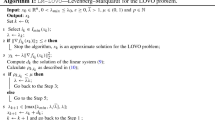Abstract
A new algorithm called Mixed L2-Linfty (ML2) estimation is proposed in this paper; it combines both the weighted least squares and the worst-case parameter estimations together as the cost function and strikes the right balance between them. A robust ML2 algorithm and a practical approximate robust ML2 algorithm are also developed under disturbance signals. The properties of the new robust ML2 algorithm are analyzed and the simulation results are given to show the convergence and the validity.
Similar content being viewed by others
References
Abdi, H.: Least-squares. In: Lewis-Beck, M., Bryman, A., Futing, T. (eds.) Encyclopedia for Research Methods for the Social Sciences, pp. 559–561. Sage, Thousand Oaks (2003)
Bai, E., Nagpal, K.M., Tempo, R.: Bounded-error parameter estimation: noise models and recursive algorithms. Automatica 32(7), 985–999 (1996)
Bar-Shalom, Y., Li, X.R., Kirubarajan, T.: Estimation with Applications to Tracking and Navigation. Wiley, New York (2002)
Bjorck, A.: Numerical Method for Least Squares Problems. SIAM, Philadelphia (1996)
Chandrasekaran, S., Golub, G.H., Gu, M., Sayed, A.H.: Parameter estimation in the presence of bounded data uncertainties. SIAM J. Matrix Anal. Appl. 19(1), 235–252 (1998)
Date, P., Vinnicombe, G.: New untuned algorithms for worst case identification. In: Proc. of the 37th IEEE Conf. on Decision and Control, Tampa, USA, pp. 1281–1286 (1998)
Ghaoui, L.E., Lebret, H.: Robust least squares and applications. In: Proc. CDC, Kobe, Japan, pp. 249–254 (1996)
Giordano, A.A., Hsu, F.M.: Least Square Estimation with Applications to Digital Signal Processing. Wiley, New York (1985)
Grinko, A.P., Karpuk, M.M.: Modification of method of least squares for tutoring neural networks. In: Proc. on Intelligent Information Systems, Sopot, Poland, pp. 157–164 (2002)
Gu, G., Khargonekar, P.P.: A class of algorithm for identification in H ∞. Automatica 28, 299–312 (1992)
Helmicki, A.J., Jacobson, C.A., Nett, C.N.: Control-oriented systems identification: a worst-case/deterministic approach in H ∞. IEEE Trans. Autom. Control 36, 1163–1176 (1991)
Hulland, J.: Use of Partial Least Squares (PLS) in strategic management research: a review of four recent studies. Strateg. Manag. J. 20(2), 195–204 (1999)
Johansson, R.: System Modeling and Identification. Prentice-Hall, Englewood Cliffs (1993)
Makila, P.M., Partington, J.R., Gustafsson, T.K.: Worst-case control-relevant identification. Automatica 31(12), 1799–1820 (1995)
Narendra, K.S., Annaswamy, A.M.: Stable Adaptive Systems. Prentice-Hall, Englewood Cliffs (1989)
Nguyen, D.V., Rocke, D.M.: Multi-class cancer classification via partial least squares with gene expression profiles. Bioinformatics 18(9), 1216–1226 (2002)
Nievergelt, Y.: A tutorial history of least squares with applications to astronomy and geodesy. J. Comput. Appl. Math. 121(1), 37–72 (2000)
Simpson, P.K.: Fuzzy min-max neural networks—part 1: Classification. IEEE Trans. Neural Netw. Syst. 3(5), 776–786 (1992)
Simpson, P.K.: Fuzzy min-max neural networks—part 2: Clustering. IEEE Trans. Fuzzy Syst. 1(1), 32–45 (1993)
Stewart, C.V.: Robust parameter estimation in computer vision. Soc. Ind. Appl. Math. Rev. 41(3), 513–537 (1999)
Tempo, R., Wasildowski, G.: Maximum likelihood estimators and worst case optimal algorithm for system identification. Syst. Control Lett. 10, 265–270 (1988)
Zhang, X.H., Hang, C.C., Tan, S., Wang, P.Z.: The differentiation of min-max functions and learning of fuzzy neural networks. IEEE Trans. Neural Netw. 7(5), 1139–1150 (1996)
Zheng, W.X.: Modified least-squares identification of linear systems with noisy input and output observations. In: Proc. of the 35th IEEE Conf. on Decision and Control, Kobe, Japan, pp. 1067–1068 (1996)
Zhu, Q., Tan, S., Qiao, Y.: High-order recursive quadratic learning algorithm. In: Lecture Notes in Computer Science, vol. 3514, pp. 90–98. Springer, Berlin (2005)
Zhu, Q., Tan, S., Qiao, Y.: A robust high-order recursive quadratic algorithm for linear-in-the-parameters models. In: The 17th International Association of Science and Technology for Development (IASTED) Conference on Modeling and Simulation, Montreal, Canada, May 2006, pp. 476–481
Author information
Authors and Affiliations
Corresponding author
Rights and permissions
About this article
Cite this article
Zhu, Q., Qiao, Y. & Tan, S. A Robust High-Order Mixed L2-Linfty Estimation for Linear-in-the-Parameters Models. J Sci Comput 38, 185–206 (2009). https://doi.org/10.1007/s10915-008-9231-7
Received:
Revised:
Accepted:
Published:
Issue Date:
DOI: https://doi.org/10.1007/s10915-008-9231-7




